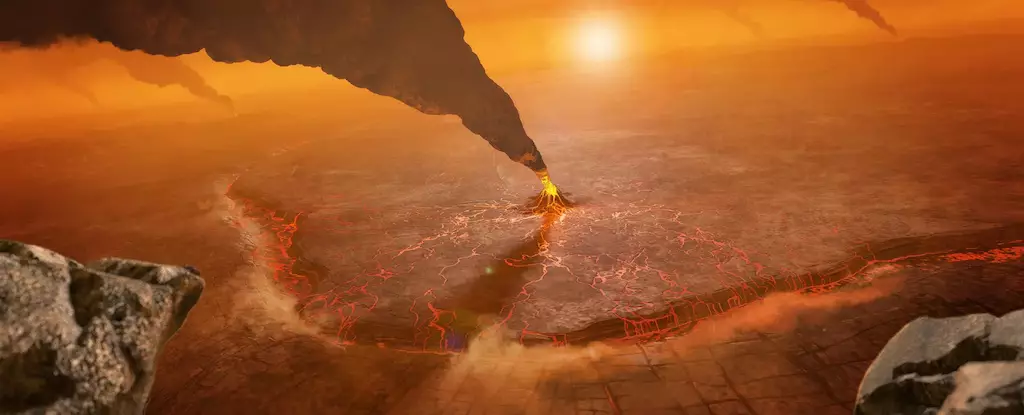For decades, Venus has been shrouded in mystery—a planet with temperatures hot enough to melt lead and an atmosphere dense with toxic gas. Traditionally viewed as a hellish counterpart to Earth, it is easy to forget that beneath this impenetrable façade there may lie a dynamic world. Recent studies suggest that Venus, long considered inactive geologically, actually presents signs of ongoing tectonic-like processes. This revelation can drastically shift our understanding of planetary geology and how it relates to Earth, deepening the intrigue surrounding our nearest planetary neighbor.
The Power of Ancient Data
New insights are often hidden in plain sight, waiting for a new generation of scientists to peel back layers of historical data. With the analysis of long-forgotten observations collected by NASA’s Magellan probe in the 1990s, researchers have turned their attention to structures known as coronae. Unlike typical craters, these large, dome-like formations may signify more than mere geological scars; they potentially reflect active processes beneath Venus’s harsh surface. Gael Cascioli, a planetary scientist, posits that these coronae could act as pivotal indicators of the planet’s underlying mechanics.
As scientists venture deeper into the study of coronae, their findings reveal that these structures have characteristics that parallel ancient Earth, hinting at a time when our own planet was undergoing similar geological transformations. Such parallels could revolutionize how we conceive of planetary evolution across the solar system.
The Scientific Significance of Coronae
The significance of coronae extends far beyond mere curiosity. With their raised rings and sunken centers, these formations were initially misunderstood as impact craters. However, their volcanic origins point to the presence of active mantle plumes pushing material from beneath the surface. When this molten material cools, it results in structures that indicate tectonic-like activity, albeit in a fundamentally different form from what we observe on Earth.
What makes these coronae particularly fascinating is their ability to unveil processes akin to those driving our own planet’s geology. On Earth, tectonic plates constantly shift, creating a vibrant landscape. By contrast, Venus lacks these plates but exhibits evidence of internal activity that causes deformations, presenting a different but equally compelling narrative of geological change. As researchers delve into the formation of these remarkable structures, they seem to discover that Venus mirrors some aspects of Earth’s geological history, albeit in a more complex and varied manner.
Models of Tectonic Processes
The recent surge of interest in coronae has been fueled by the development of sophisticated models that simulate their formation through mantle plumes. Researchers examine different scenarios to better understand the mechanics behind these geological phenomena. By employing topography and gravity data obtained from the Magellan mission, scientists have identified 75 unique coronae. What’s particularly striking is that more than two-thirds of them are associated with buoyant plumes of magma, hinting at an active geological world beneath the planet’s surface.
The idea of tectonic processes operating on Venus is exhilarating. Researchers propose two phenomena akin to Earth’s own geological dynamics: subduction and lithospheric dripping. On Earth, when tectonic plates collide, one marginally slips beneath the other, a process known as subduction. While Venus lacks the conventional plate structure, it may still experience analogous interactions—where buoyant plumes push surface materials outward, leading to collisions that dive some materials back into the mantle.
The theory of lithospheric dripping further solidifies the notion that Venus is not a stagnant world. As heat from below melts parts of the crust, resulting drips of denser material could be falling back beneath the surface, suggesting an internal cycle of material movement. This ongoing activity challenges the view of Venus as a simple, static entity.
Challenges of Exploration and Future Investigations
As we marvel at these groundbreaking revelations, we must also acknowledge the considerable hurdles to exploring Venus further. Excruciating surface temperatures and atmospheric pressure make it extraordinarily difficult for robotic missions to gather direct evidence. Yet, as scientists underscore the potential for ongoing geological activity, the urgency for more focused investigations becomes apparent. Future missions should prioritize studying coronae to elucidate the hidden processes governing the planet’s geology.
The insights gained from Venus don’t just propel our curiosity; they compel us to rethink our understanding of geological processes in the universe. As we unlock the tantalizing secrets of coronae and the tectonic-like activities below, we may find ourselves one step closer to understanding not only Venus but the broader narrative of planetary formation and evolution within our solar system. This thrilling prospect reshapes our relationship with our cosmic neighbor and invites new dialogues about the nature of worlds beyond our own.


Leave a Reply